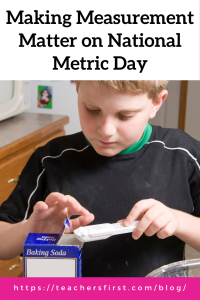Measurement is a mathematical and scientific skill we use daily, but it’s often only explored in singular lessons or units rather than infused throughout the math and science curriculum. Helping students experience measurement as a natural way they “see” and “do” math is essential for building a mathematical mindset.
The National Council of Teachers of Mathematics (NCTM) created National Metric Day on October 10,1983. This holiday provides a unique opportunity for teachers to infuse measurement and number sense into their instruction. Below, we will dive deeper into why and how to make measurement matter to students and share a variety of easy-to-implement lesson ideas.
Why Measurement Matters
Measurement is a bedrock principle of math and science and is one of the five Content Standards defined by NCTM, which aims to ensure that students can “understand measurable attributes of objects and the units, systems, and processes of measurement” and “apply appropriate techniques, tools, and formulas to determine measurements.” According to an article written by former NCTM president Henry Kepler, measurement is also a concept that many students struggle to find relevant because they don’t encounter it frequently in their day-to-day experiences. In addition to providing a strong foundation for future learning, teaching measurement skills also develops critical mathematical process skills, including attending to precision and using appropriate tools strategically (both of which are components of the Common Core Standards for Mathematical Practice).
In “Measure for Measure” in the NCTM News Bulletin (NCTM, May/June 2009), former NCTM President Henry Kepler wrote a call to action to make measurement relevant to students. He encouraged focusing on choosing an appropriate measurement unit and the idea that measurement is always approximate. He also emphasized that the metric system needs to be a focus despite the prevalent use of the Imperial System (customary units) in the United States.
Teaching measurement skills also develops critical mathematical process skills, including attending to precision and using appropriate tools strategically (Common Core Standards for Mathematical Practice).
How To “Math” With Measurement
One way teachers can introduce measurement is to interject mathematical think-alouds about what they notice and wonder regarding the shape, size, and weight of objects in their classroom. For example, if students are charging their devices, you might ask students to think about the speed at which they’re charging and estimate how long it will take to charge to full capacity from the current battery percentage. When noticing the fall leaves outside a classroom, you might ask students to think about how they could estimate and attempt to determine the height of the now-visible tree branches or compare their height to the tree’s height.
In an American Educator article, Stanford professor Jo Boaler notes that “when students see math as a broad landscape of unexplored puzzles in which they can wander around, asking questions and thinking about relationships, they understand that their role is thinking, sense making, and growing.” The more we can inspire students to develop mathematical questions that help them give meaning to their world, the more they will naturally engage in mathematical thought.
Metric Day Lesson Ideas
- Metric Olympics – Create a series of “math-ing” events that require metric measurements, such as a paper airplane flying contest (distance in meters), a water balloon toss (distance in centimeters), or a beanbag toss (distance in millimeters). Students can simultaneously practice data collection while competing in events, providing a rich opportunity for post-competition data analysis using authentic data that’s relevant to students. Consider starting a data analysis conversation with a graphing or chart tool such as Livegap Charts (reviewed here) or Data Gif Maker (reviewed here).
- Metric Conversions Challenge – Use an AI tool like MagicSchool (reviewed here) or SchoolAI (reviewed here) to build question sets that require conversions between various metric units. Consider creating levels with increasing difficulty and give multi-step conversion problems at higher levels. This practice is a great way to integrate number sense and start a discussion about the base ten number system.
- Metric Recipes – Have students find or create recipes that use metric measurements. Often, baking recipes use metric weights for measurements. Consider having the class build a menu of recipes using Padlet (reviewed here) or Wakelet (reviewed here). Students can then share the link with their family and try to make a recipe at home to see if and how metric measurements benefit the cooking process.
- Metric Scavenger Hunt – Create a list of items students must find around the school or at home, measuring each item in metric units. Consider using Goosechase edu (reviewed here) to add a technology element to the hunt, allowing students to capture images or videos while finding and measuring these items. This activity is an excellent opportunity to discuss accuracy and precision and allow students to test their estimation skills before using a measuring tool.
- Metric Math Problems – Have students level up word problems in their math textbooks or lessons that use customary units and ask them to rewrite them using appropriate metric units. This helps students focus on the idea of equivalency while considering how the choice of a measurement unit helps explain the context of a situation.
More Metric System Activities & Resources
- Explore the TeachersFirst special topics collection for Math Resources for Measurement in Grades K – 2, Grades 3 – 5, Grades 6 – 8, or Grades 9 – 12.
- US Metric Association Puzzles and Quizzes
What suggestions do you have for making measurement matter in your classroom? Share your ideas in the comments so we can “math” together!


